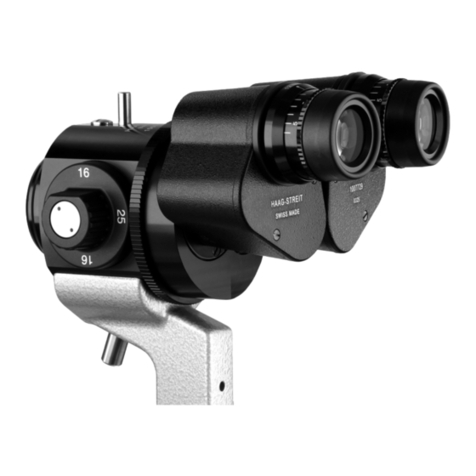
3
DEUTSCHENGLISH FRANÇAIS ITALIANO ESPAÑOL NEDERLANDS
PORTUGUÊS SVENSKA
DEUTSCHENGLISHFRANÇAISITALIANOESPAÑOLNEDERLANDS PORTUGUÊS
SVENSKA
© HAAG‑STREIT AG, 3098 Koeniz, Switzerland ‑ HS‑Doc. no. 1500.7220505‑04060 – 2021 – 08
Contents
¥ 1 Safety...................................................................................................................................................4
◦ 1.1 Comments on these instructions for use........................................................................................4
◦ 1.2 Ambient conditions.........................................................................................................................4
◦ 1.3 Shipment and unpacking ...............................................................................................................4
◦ 1.4 Installation warnings ......................................................................................................................4
◦ 1.5 Operation, environment .................................................................................................................5
◦ 1.6 Light toxicity ...................................................................................................................................5
◦ 1.7 Disinfection ....................................................................................................................................6
◦ 1.8 Warranty and product liability ........................................................................................................6
◦ 1.9 Reporting obligation.......................................................................................................................6
◦ 1.10 Description of symbols.................................................................................................................6
¥ 2 Intended purpose / intended use .......................................................................................7
◦ 2.1 Device description..........................................................................................................................7
▪ 2.1.1 Intended users....................................................................................................................7
◦ 2.2 Medical purpose.............................................................................................................................7
▪ 2.2.1 Indications...........................................................................................................................7
▪ 2.2.2 Part of the body ..................................................................................................................7
▪ 2.2.3 Patient population...............................................................................................................7
▪ 2.2.4 Contraindications................................................................................................................7
◦ 2.3 Principles of operation ...................................................................................................................7
▪ 2.3.1 Operating environment .......................................................................................................8
◦ 2.4 Clinical benefit................................................................................................................................8
¥ 3 Introduction .....................................................................................................................................8
◦ 3.1 Overview........................................................................................................................................8
◦ 3.2 Overview LED illumination.............................................................................................................9
◦ 3.3 LED illumination LI02 plus .............................................................................................................9
▪ 3.3.1 Blue filter.............................................................................................................................9
▪ 3.3.2 Background illumination......................................................................................................9
¥ 4 Device assembly / installation ...........................................................................................10
◦ 4.1 Placement of adhesive label for the automatic left/right detection...............................................10
◦ 4.2 Camera assembly........................................................................................................................10
◦ 4.3 Cabling of the RM02 (diagram)....................................................................................................10
◦ 4.4 Microscope and illumination.........................................................................................................11
◦ 4.5 Step-by-step cabling ....................................................................................................................11
¥ 5 Commissioning ...........................................................................................................................13
◦ 5.1 Switching on the device ...............................................................................................................13
¥ 6 Operation.........................................................................................................................................13
◦ 6.1 Setting the eyepieces...................................................................................................................13
◦ 6.2 Field of view.................................................................................................................................13
◦ 6.3 White balance ..............................................................................................................................13
▪ 6.3.1 Slit lamp preparation.........................................................................................................13
▪ 6.3.2 Conducting a white balance..............................................................................................14
◦ 6.4 Software / Help menu / Error messages...................................................................................... 14
◦ 6.5 Preparing the patient ...................................................................................................................14
◦ 6.6 Operating the device ...................................................................................................................14
◦ 6.7 Setting the filters & diaphragms................................................................................................... 16
◦ 6.8 Fixation star................................................................................................................................. 16
◦ 6.9 Microscope and eyepiece............................................................................................................ 16
◦ 6.10 Reduced operation ....................................................................................................................16
◦ 6.11 LED indicator illumination head................................................................................................. 17
◦ 6.12 LED indicator power supply....................................................................................................... 17
◦ 6.13 LED indicator release module RM02......................................................................................... 17
◦ 6.14 LED indicator camera................................................................................................................ 17
◦ 6.15 Error messages (illumination head)........................................................................................... 18
◦ 6.16 Error messages release module RM02..................................................................................... 18
◦ 6.17 Error messages camera ............................................................................................................18
◦ 6.18 Software / Help menu / Error messages.................................................................................... 19
¥ 7 Decommissioning ..................................................................................................................... 19
¥ 8 Technical data ............................................................................................................................. 19
◦ 8.1 Slit illumination............................................................................................................................. 19
◦ 8.2 Power supply............................................................................................................................... 19
◦ 8.3 Stereo microscope....................................................................................................................... 20
◦ 8.4 Instrument base........................................................................................................................... 20
◦ 8.5 Dimensions.................................................................................................................................. 20
◦ 8.6 Camera........................................................................................................................................ 20
◦ 8.7 Minimum PC requirements.......................................................................................................... 20
¥ 9 Maintenance.................................................................................................................................. 21
◦ 9.1 Device inspection ........................................................................................................................21
◦ 9.2 Service......................................................................................................................................... 21
◦ 9.3 Cleaning and disinfection ............................................................................................................ 21
◦ 9.4 Replacing the illumination mirror .................................................................................................21
◦ 9.5 Dust cover ...................................................................................................................................22
¥ 10 Appendix ...................................................................................................................................... 22
◦ 10.1 Accessories / functionals parts / detachable parts / consumables ............................................22
◦ 10.2 Legal regulations .......................................................................................................................22
◦ 10.3 Classification ............................................................................................................................. 22
◦ 10.4 Disposal..................................................................................................................................... 23
◦ 10.5 Observed standards ..................................................................................................................23
◦ 10.6 Information and manufacturer's declaration concerning electromagnetic compatibility (EMC) .23
▪ 10.6.1 General........................................................................................................................... 23
▪ 10.6.2 Emitted interference .......................................................................................................24
▪ 10.6.3 Electromagnetic immunity environment tested (part 1).................................................. 25
▪ 10.6.4 Electromagnetic immunity environment tested (part 2).................................................. 26
▪ 10.6.5 Recommended separation distances between portable and mobile RF communications
equipment and this product....................................................................................................... 28






























